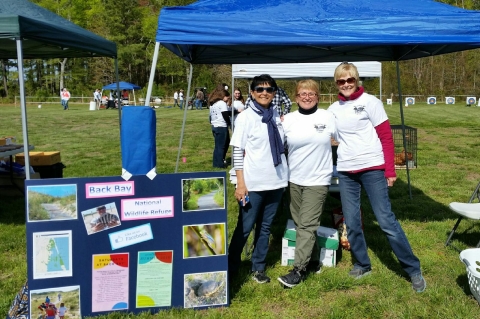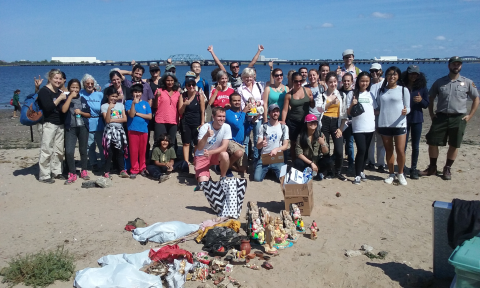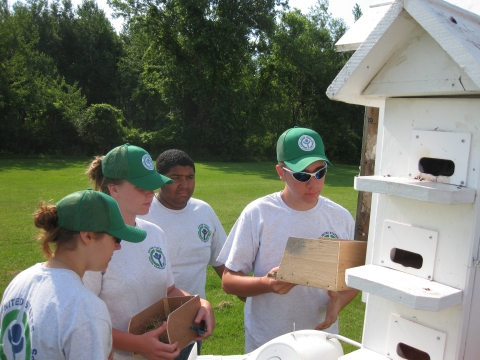EcoTips
Earth Day remains a day to honor our planet and build a healthy environment for future generations. We are providing helpful tips and information for you and for families. Then, head over to check out our fun, virtual and in-person activities. .
Take action on Earth Day with our Eco Tips where you will find a range of easy activities. We would like you to consider doing something to make a better planet for fish, wildlife and their habitat. There is plenty you can do with your families and friends at home, in your neighborhood or at school. Plant a tree, pick up litter, remove invasive plants, clean-up a beach...the opportunities are endless. Earth Day is every day!
1) Volunteer
Imagine conducting plant and animal surveys at a national wildlife refuge, assisting with conservation education activities at a national fish hatchery, leading tours and helping with field trips, restoring habitat, maintaining a trail and so much more. Volunteers of all ages play a vital role in helping us meet our conservation goals. Volunteers help serve the nearly 50 million people who visit public lands managed by the Service each year. We welcome volunteers of all backgrounds and abilities. Volunteers can work a few hours a week or at single–day events, such as National Public Lands Day, Earth Day and the Christmas Bird Count.
2) Plant native
You can help! Every backyard can become an oasis for monarchs and other pollinators — even in cities. To attract a variety of pollinators, include a selection of plants native to your region. You can order seeds of wildflowers native to your region that will give you low-maintenance blooms next spring and all summer long. Not only will they thrive — they’ll support native birds, insects and other pollinators that depend on familiar, home-grown species for a healthy ecosystem. Consider the following when choosing plants for your garden:
- Choose native plants that flower at different times of the year to provide nectar and pollen sources throughout the growing season
- Plant in clumps, rather than single plants, to better attract pollinators
- If designed and managed properly, schoolyard habitats can provide students a powerful example of land stewardship.
- Provide a variety of flower colors and shapes to attract different pollinators
- Contact your local or state native plant society for help.
3) Create schoolyard habitat
Schoolyard Habitat projects are designed to achieve the mission and goals of the school, the Service and the community. They address multiple environmental and educational concepts that benefit all involved, particularly the students.
The benefits of a Schoolyard Habitat Program include:
- Improved habitat: Schoolyard habitat projects provide habitat for local and migratory wildlife including songbirds, shorebirds, small mammals, reptiles, amphibians and insects.
- Teaching and learning: Schoolyard habitats offer many teaching and learning opportunities. Research shows that using the environment as a focal point of teaching improves student performance.
- Stewardship: If designed and managed properly, schoolyard habitats can provide students a powerful example of land stewardship.
- Social development: A well-designed schoolyard including a diversity of natural areas, allows students to exercise these innate needs leading to a happier and more fulfilled childhood.
4) Pick-up litter
Don’t litter. Trash tossed carelessly outside washes into storm drains, which empty into rivers and streams that eventually flow to the oceans. Trash adversely affects the habitat of marine and other aquatic environments causing death and injury to seabirds, fish, marine mammals, turtles and other species through swallowing and entanglement. Common litter includes plastic bags, paper, candy wrappers, fast-food packaging, bottle caps, glass bottles, plastic six-pack rings and plastic straws. Spend one hour picking up litter. Organize a team of family, friends, or co-workers to pick up litter in your local neighborhood, wildlife refuge or park. Enjoy making a difference, getting exercise, getting to know people better and having cleaner surroundings. Once they get loose, balloons can also pose a threat to many animals. Find alternatives to letting a balloon go.
5) Prevent stormwater runoff
Poor water quality can harm fish, wildlife and their habitat. Many things are known to cause poor water quality, including sedimentation, runoff, erosion and pesticides. Stormwater runoff occurs when rainfall flows over the ground. Stormwater runoff picks up debris, chemicals, dirt and other pollutants from hard (impervious) surfaces and washes them into storm drains. Anything that enters a storm drains flows often untreated into the rivers and streams that we use for swimming and drinking water. How you can help:
- All vehicle fluids are toxic and extremely harmful to the environment. Recycle used oil in a clean, sealed, plastic container.
- SWEEP! Hosing off pavements washes pollutants into storm drains leading straight to the river.
- Deliver old paint, pesticides, solvents and batteries to your local hazardous waste drop off facilities. Pouring hazardous substances down a storm drain, onto the ground or into a stream creates a danger to all, as well as the environment.
- Street litter, such as styrofoam, plastic, and paper can be prevented from blowing into inlets by keeping trash bins covered and by not littering.
- Yard waste, such as grass clippings, tree trimmings and leaves can be composted and used for fertilizer around the yard.
6) Going on vacation?
- Turn the heat down and turn off the water heater before you leave your home.
- Don’t pick flowers or collect wild creatures for pets. Leave animals and plants where you find them.
- Going abroad? Think twice about the things you buy. Travelers don’t realize that several U.S. laws and an international treaty make it a crime to bring many wildlife souvenirs into our country.
7) Reduce, Reuse, Recycle
Recycling turns materials that would otherwise become waste into valuable resources. Collecting used bottles, cans and newspapers and taking them to the curb or to a collection facility is just the first in a series of steps that generates a host of financial, environmental and social returns.
- Reuse glass and plastic bottles as planters by filling them with dirt and planting herbs or vegetables for your own indoor garden. Large coffee cans, empty milk jugs, old clay planter pots and plastic buckets can all be used successfully as plant containers.
- Newspaper can be used to wrap birthday gifts or crumple newspaper to create packaging material to keep items protected when shipping. Reuse plastic bags to line trashcans or to pick up pet waste. Avoid purchasing items that are over packaged.
- Paper or Plastic? How about a reusable tote? They are inexpensive and help to reduce the production of plastic and paper bags. Opt for a reusable water bottle as opposed to one-time-use plastic bottles.
8) Create bird habitat
As you learn to enjoy the beauty of birdlife around their home, you may wish to improve the habitat in your yard so that more birds will visit your property. You can attract birds by placing bird feeders, nest boxes and bird baths in your yard, and by planting a variety of trees, shrubs and flowers. These can provide good nesting sites, winter shelter, places to hide from predators and natural food supplies that are available year-round. Feeders can aid survival during migration and harsh winters. If you put out bird feeders, select a safe feeder and keep it clean. You should consider the location of the feeder, and whether you need to “squirrel proof.” Remember, a source of fresh water is especially important in the spring and summer. Bird baths will be used for both bathing and drinking, so it's important to clean them regularly as well.
9) Prevent invasive species invasive species
An invasive species is any plant or animal that has spread or been introduced into a new area where they are, or could, cause harm to the environment, economy, or human, animal, or plant health. Their unwelcome presence can destroy ecosystems and cost millions of dollars.
Learn more about invasive species
Everyone can play a part in preventing the introduction and spread of invasive species. There are simple steps you can take to prevent the introduction and spread of invasive species. Invasive plants displace naturally occurring vegetation and, in the process, upset nature’s balance and diversity. Helping to prevent the introduction and spread of invasive plants is the most effective way of protecting healthy, non-infested ecosystems. Here are just a few tips:
- Ask for only non-invasive species when you acquire plants. Plant only environmentally safe species in your gardens. Work towards and promote new landscape design that is friendly to regional ecosystems.
- Find information on which species are invasive in your area. Sources could include botanical gardens, horticulturists, conservationists and government agencies.
- Remove invasive species from your land and replace them with non-invasive species suited to your site and needs.
- Seek the best information on control of invasive plant species and organize neighborhood work groups to remove invasive plant species under the guidance of knowledgeable professionals.
10) Tips for Every Day
Are you and your family eco-friendly? There are lots of easy things you can do in your own homes, neighborhoods and at school every day to help save our earth, air and water. So, celebrate the Earth Day holiday by learning new ways to protect the environment together.
While at home
- Don’t put hazardous substances down the drain or in the trash. Things like paint thinner, furniture polish and antifreeze can pollute our water and land, impacting people as well as wildlife.
- Keep litter, pet wastes and leaves out of street gutters and storm drains.
- Recycle everything you can: newspapers, scrap papers, cans, glass, motor oil, plastics, appliances, etc.
- Don’t leave water running. Turn off the tap when brushing your teeth or washing your face. Install water-saving devices, such as low-flow showerheads, to save water and save money.
- Turn the lights and TV off when you leave a room. Use energy-efficient light bulbs.
In your community
- Support local natural areas and nature centers near you. Work with community members to maintain and restore habitat at a nearby national wildlife refuge.
- Walk, ride your bike, carpool or use public transportation. Organize litter cleanups and recycling drives.
- Plant native trees and bushes with berries or nuts that provide birds and other creatures with food and a place to live.
- At school, ask your teachers to help you organize clean-up days. Remove trash or invasive weeds from vacant lots or streams.




